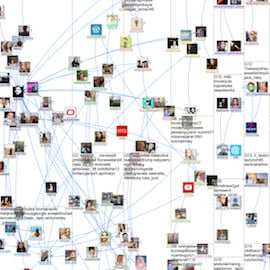Unlocking Human Potential: How Psychometric Scoring Can Turbocharge Financial Inclusion
EFL Global aims to enable lending to underserved borrowers around the world. Through work that began at the Entrepreneurial Finance Lab Research Initiative at Harvard, the firm pioneered psychometric credit scoring, a screening tool designed to identify traits key to successful entrepreneurship. In this email Q&A with NextBillion Senior Editor James Militzer, Jared Miller, CEO of EFL Global, talks about efforts by his company and others to “turbocharge” financial inclusion.
James Militzer: Briefly describe EFL’s mission, the problem you address and the potential impact of addressing it.
 Jared Miller (left): EFL helps people earn credit. Around the world, over 3 billion people are unbanked or underbanked. That’s 3 billion people without access to mainstream credit. EFL addresses this problem of financial inclusion globally by helping financial institutions approve people that would otherwise be difficult to analyze and approve for a loan.
Jared Miller (left): EFL helps people earn credit. Around the world, over 3 billion people are unbanked or underbanked. That’s 3 billion people without access to mainstream credit. EFL addresses this problem of financial inclusion globally by helping financial institutions approve people that would otherwise be difficult to analyze and approve for a loan.
EFL collects and analyzes behavioral and psychometric information about borrowers to create reliable, predictive credit scores to inform a credit decision. This approach is inclusive: We can score anyone, regardless of financial history, formal documentation or collateral (or lack thereof). You could say that we help generally underserved people turn their human potential into hard information. Everyone has a personality.
Militzer: Talk about your approach. How does psychometric credit scoring work, and why is it effective for underserved populations?
Miller: EFL relies on nontraditional data. We pioneered the use of psychometrics as evidence-based means of evaluating an individual’s ability and willingness to repay her loans based on consumer-contributed data. Psychometrics is our bread and butter, the tool we have honed over the last decade. We are also actively tapping into other forms of alternative data, such as social network and cell phone activity, to further improve our predictive power. Here’s why we think psychometrics is great:
- Creates data where there is none: Psychometrics is a reliable and predictive method of building a credit score for people who lack deep credit histories. In this way, EFL can predict risk on previously “unscorable” populations.
- Boosts predictive power of traditional scores: EFL has demonstrated that combined with bureau scoring models, it can reduce risk and increase lending, expanding access to credit.
- Removes human bias: When loan decisions are made based on human relationships, bias can be introduced despite best intentions. EFL’s credit scoring strips out that bias and predicts risk within a borrower population.
- Reduces acquisition and operational costs: Perhaps the major benefit of alternative data is quicker turnaround time for the end client at a lower cost. Technology can reduce the need for human-centered processes and is more scalable. This is especially true in the digital lending world – a trend that only appears to gather steam with startups and traditional financial institutions.
Militzer: Do you have any anecdotes and/or numbers that illustrate the kind of impact you’re providing to consumers and lenders through this approach?
Miller: To date, EFL’s universal credit score has been used to empower and optimize over $1 billion in lending around the world, and our database is doubling yearly.
Our universal credit assessment has been locally customized to power credit decisions in 30-plus countries, 20-plus languages and counting. Through this work, EFL has helped lending institutions increase loan volumes by 3x, lower default rates by 40 percent, and reduce operational costs.
Militzer: Your website mentions that your credit scoring model gauges the “ethics, honesty, intelligence, attitudes and beliefs” of potential borrowers. Are these factors alone enough to enable lenders to make sound decisions, or do you recommend they use your test scores to complement more traditional assessments of creditworthiness?
Miller: As a general rule, more predictive data is better so the ideal credit decision is informed by predictive traditional and nontraditional data. EFL is a response to the absence of universally available, high-quality traditional data and thus many partners use the EFL universal credit score on its own. But even in combination with traditional data, creating the chance to approve someone safely based on new information is a breakthrough for many financial institutions.
We recently announced a partnership with FICO to allow partners to more easily combine our scoring methodologies. This strategic alliance underscores how alternative data is becoming more trusted and critical as part of credit decisions.
Militzer: I understand your psychometric testing relies on a written test, with some visuals. Is there a risk that this format could exclude less educated/literate borrowers – or those who are unaccustomed to, or anxious in, testing situations?
Miller: Over the last 10 years, we have been dedicated to creating and improving the most accessible, understandable and enjoyable assessment. You can take a tour of what it looks like here. With each iteration of our assessment, it becomes more visual, more interactive, more fun and less verbal to account for differences in literacy across our audiences. This is something we think a lot about, and continue to improve on.
Depending on the financial institution we are partnering with, the assessment can be delivered online, through SMS/chat bots, or on a tablet with support from a loan officer. Additionally, we have built-in measures within the assessment to highlight when applicants do not seem to understand the content.
Militzer: I also understand you’ve taken numerous measures to discourage and detect cheating on the tests, such as applicants getting someone else to help them, or answer for them. How does this work, and how big a problem has this turned out to be (ie: what percentage of applications are rejected due to suspicious behavior)? Can borrowers “study” or prepare for the test in other, legitimate ways?
Miller: For everyone who takes the assessment, we share a three-digit credit score and an answer reliability score which conveys indicators of cheating or gaming. On average about 5 percent of tests taken are flagged for cheating or gaming.
Here are some of the ways that we ensure applicants (including the loan officers who may be assisting them) cannot cheat:
- Content randomization: Every application includes different questions and ordering. It is impossible for applicants to share or sell their results.
- New content: EFL is constantly developing new content, so the questionnaire is never the same.
- No obvious right or wrong answers: And when a person attempts to “game” the application we use that behavior as a red flag for honesty.
- Answer pattern analysis: The scoring system detects when loan officers have been assisting applicants, as well as when answers display unusual and unlikely patterns.
Given these safeguards, EFL is able to reduce and eliminate gaming and fraud.
Militzer: What’s your take on some other alternate methods of assessing the creditworthiness of underserved borrowers, like using their social network or mobile phone activity? How do they measure up to psychometric testing, and what are some pros/cons to the different approaches?
Miller: As a pioneer in enabling access to credit to those who have never qualified, we are thrilled to see additional forms of alternative data in the market. Some of the top new alternative data sources we see are mobile phone activity and social network data. EFL has already begun incorporating some of these techniques into our scoring.
Mobile phone activity and call detail records (CDR)
Pros: Once data is in hand, makes for relatively quick scoring; can boost predictive power
Cons: Difficult to procure from telcos or convince consumers to download an app that will scrape their phone; data may be skewed by multiple people on the same plan, change of plans, etc.
Social network engagement data (i.e. Facebook, Twitter, etc.)
Pros: Fast to incorporate and score; can boost predictive power in concert with other types of data
Cons: Privacy concerns; length of access; limited impact on predictive power on its own
Overall these are two examples of an emerging world of alternative data. In the future we will see more data sources created and applied to the challenge of financial inclusion.
Militzer: Talk about EFL’s new partnership with FICO, in which I understand your technology will be made available to FICO clients to reach underserved borrowers outside the U.S. How big a change will this represent to FICO’s approach to reaching new borrowers (ie: will all FICO clients in the countries targeted now be scored with psychometric testing)? Will it be optional or mandatory? And will it ever be available for underserved borrowers in the U.S.?
Miller: As part of its FICO Financial Inclusion Initiative, FICO has a strategic partnership with EFL to expand credit scoring options for lenders and consumers. FICO is offering EFL’s psychometric scoring alongside its own credit scoring products in global markets, with the initial focus on Turkey, Russia and Mexico.
The FICO Financial Inclusion Initiative focuses on addressing the needs of the over 3 billion consumers globally who lack credit access. These consumers who lack access to mainstream banking benefit from credit scores that leverage multiple data sources to assess credit risk and assist responsible lending.
What this means is that clients and potential clients of FICO’s will have the option to use EFL’s universal credit score alongside FICO’s suite of products.
At this time, EFL and FICO’s work together is focused outside of the United States only.
Militzer: How big a deal is the FICO Financial Inclusion Initiative – and the fact that it features partnerships with EFL and Lenddo – for the alternate credit scoring “movement”? What does it mean to have such a major industry player validating these approaches and incorporating them into its work?
Miller: We are thrilled to be a part of FICO’s Financial Inclusion Initiative and we suspect this is a turning point for alternative data’s role in credit decisioning. While FICO has been focused on optimizing traditional credit scoring, we have spent the last decade building and validating an entirely new way of predicting risk. EFL’s capabilities and track record, combined with FICO’s expertise and distribution, will turbocharge financial inclusion globally.
Check back with us to see how our mission of breaking down financial barriers to unlock human potential around the world is unfolding. Follow along on our blog.
James Militzer is the senior editor of NextBillion.
Photo: A small business owner in Peru who received a loan thanks to EFL’s universal credit score, by Gabriela Bhaskar.
- Categories
- Uncategorized



